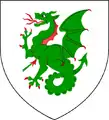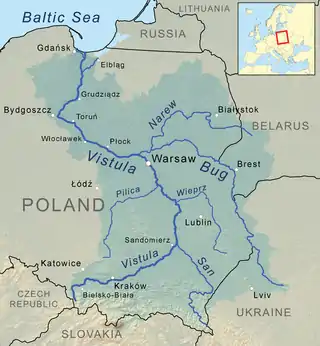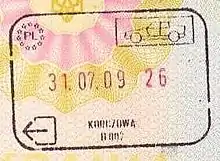Krakovets
Krakovets (Ukrainian: Краковець, Polish: Krakowiec (original spelling), Yiddish: Krakovits; also found on American immigration documents as Krakowicz and Krakowice) is an urban-type settlement in Yavoriv Raion, Lviv Oblast, in western Ukraine. It lies on the Ukrainian-Polish border, roughly half way between Lviv in Ukraine and Kraków in Poland. The population was estimated at 1,144 (2020 est.)[1] .
Krakovets
Krakowiec Краковець | |
|---|---|
 Coat of arms | |
 Krakovets Location of Krakowiec in Ukraine  Krakovets Krakovets (Europe) | |
| Coordinates: 49°57′30″N 23°9′26″E | |
| Country | |
| Oblast | |
| Municipality | Lviv |
| Founded | 1320 |
| Area | |
| • Total | 1.46 km2 (0.56 sq mi) |
| Elevation | 209 m (686 ft) |
| Population (2020) | |
| • Total | 1,144 |
| • Density | 780/km2 (2,000/sq mi) |
| Time zone | UTC+2 (EET) |
| • Summer (DST) | UTC+3 (EEST) |
| Postal codes | 81034 |
| Area code(s) | +380 32(59) |
Etymology

.svg.png.webp)
The root Krak associated with the early West Slavic rulers or their coats of arms (Krak var. Krok) may be connected to Druk (Drak, Dragon), present in various legends about Kraków's earliest history. The most prominent one is the legend of the Wawel Dragon, a late version of the ancient Proto-Indo-European mythology of Dragon or Serpent (zmei, smok).
The Dragon and Griffin) coat of arms were used in Europe by Scythian/Sarmatian and Celtic noble clans already during the 1st millennium BCE.
Alternative and/or supplementing etymologies may be connected to Kurdish or Syriac language krak or karak (fortress, castle) as in Krak des Chevaliers or Polish krokiew (rafter) - both from the Indo-European root *kroku- ~ *krokieha- 'post'. [IEW 619 (*krëk-); Buck 19.17]·. From *kroku-: OIr crīch (< *krekueha boundary marker?) end, boundary, Wels. crib point, Rus. krokva stake; from krokieha- : Lith. krāke post, Grk. (pl.) κροσσαι crenellation. Cf. also Lith. kreklas rafter. At least a word of the west and center of the IE world.[2]
History

The ancient Slavic-Scythian settlement of Krakowiec at the Szkło river (a tributary of San)[3] seems to have become wooden fortifications after the Turko-Mongol raids of the 13th century and received town privileges in 1520. In 1590 Aleksander Ostrogski built the Krakowiec castle. The town became property of the Cetner, Potocki and Lubomirski families and remained a small strategic outpost protecting the core territories of Crown of the Kingdom of Poland and its capital Kraków from invasions of the Khazar Khaganate, Varangians, Pechenegs, Golden Horde, Nogais, Ottoman Empire, Tatars, Cossacks, Grand Duchy of Moscow and their successors.
Until the Partitions of Poland in 1772 Krakowiec was part of the Przemyśl Land of the Ruthenian Voivodeship (Rusyn Satrapy), part of Lesser Poland Province of the Crown of the Kingdom of Poland of the Polish–Lithuanian Commonwealth. During Partitions of Poland the town became part of Galicia in the Austro-Hungarian Empire.
In 1923 Krakowiec returned to Poland, but shortly thereafter in 1939, according to the Molotov–Ribbentrop Pact, Krakowiec became victim of genocide, ethnocide and other crimes and atrocities detailed by Gestapo–NKVD conferences, e.g. the Massacres of Poles in Volhynia and Eastern Galicia performed by Ukrainians of Turkic and Germanic roots and after the establishment of District of Galicia in 1941 The Holocaust (Shoah) of the Jews. After World War Two, Krakowiec became part of Ukrainian Soviet Socialist Republic, part of the Soviet Union and was since known as Krakovets. In 1990 Krakovets became part of the independent Ukraine, since 2014 invaded by Russia.
Changing nationalities

In the Polish–Lithuanian Commonwealth and also between 1772 and 1918, under Austrian rule, and continuing under Polish rule until the Second World War, the inhabitants of Krakowiec were a multi-national and multi-cultural mix of ethnic Poles, Polans, Lemkos, Boykos, Drevlyans, Volhynians, Sarmatians (Iazyges, Iaxamates, Siraces, Alans, Roxolani, Serboi...), White Croats, Ukrainians, Byelorussians, Lithuanians, Yotvingians, Arya, Silesians, Armenians, Lipka Tatars, Germans and Ashkenazi Jews. In the era of the decline of multi-national empires and the rise of nation states, the Poles were deported or killed, the Jews were slaughtered en masse, and as a result of genocide, Krakowiec became an exclusively Ukrainian town.[4] In 1945 the remaining Polish and Sarmatian survivors were deported, mainly to Silesia (Bytom, Brzeg, Wrocław, Legnica...).
The destruction of the Jews of Krakowiec
Before the Nazi invasion of Poland and establishment of the General Government, it is estimated that between one-third and one-half of the citizens of Krakowiec—1,000 or more people—were Jewish. Krakowiec was also the birthplace of the Ukrainian Insurgent Army general Roman Shukhevych (1907-1950), who shot Jews on sight in at least two villages and is said to have been involved in the June–July 1941 massacre of over 4,000 Jews in pogroms in Lviv and other cities in western Ukraine.[5] Following that atrocity, most of the Jews of Krakowiec perished in the ghettos, labor camps, and death camps of the holocaust.[6][7]
The nearby Bełżec extermination camp, one of the biggest extermination camps in human history, was just around 50 km (30 miles) away.
Border crossing

A border crossing into Poland is located in Krakovets. The town across the border in Poland is Korczowa. As Poland became part of the Schengen Area on 21 December 2007, this border crossing is a Schengen external border. The European route E40 crosses the border here. The eastern terminus of Poland's National Road 4 and the Polish A4 motorway are located at Korczowa.
References
- "Чисельність наявного населення України (Actual population of Ukraine)" (PDF) (in Ukrainian). State Statistics Service of Ukraine. Retrieved 30 September 2020.
- Mallory, J.P.; Douglas Q. Adams (1997). Encyclopedia of Indo-European Culture. London: Fitzroy Dearborn Publishers. p. 441. ISBN 978-1-884964-98-5.
- Słownik geograficzny Królestwa Polskiego i innych krajów słowiańskich, Tom XI, page 921
- Jews and their Neighbours in Krakowiec by Bernard Wasserstein
- Holocaust and Memory in Europe; Holocaust Amnesia: The Ukrainian Diaspora and the Genocide of the Jews by Grzegorz Rossolinski-Liebe
- Krakovets, Ukraine, at JewishGen
- Jewish Gen edition of Swastika over Jaworow by Samuel Druck, pages 12, 15, etc.
External links
- Krakovets at the Verkhovna Rada website
- Krakovets at the Castles and Temples of Ukraine
- Jewish Cemeteries of Krakovets
See also
- Duke Krok
- Krakus
- Krakus II (Krak's son)
- Lech II (Krak's son)
- Princess Wanda (Krak's daughter)
- Kraków
- Krakov
- Krakovec
- Krakovany (Bohemia)
- Krakovany (Slovakia)
- Kraków (Pomerania) of the Griffin dynasty)
- Kraków (Western Pomerania) of the Griffin dynasty)
- List of Mongol and Tatar attacks in Europe
- Tatar slave raids in East Slavic lands
- Aleksandra Lisowska
- Jasyr
- Janissaries
- Devshirme
- Mamluk
- Gulag
- Holodomor
- Massacres of Poles in Volhynia and Eastern Galicia